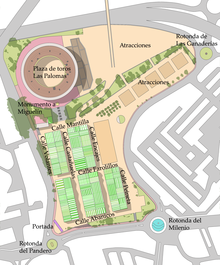
Cádiz is a province of southern Spain, in the southwestern part of the autonomous community of Andalusia. It is the southernmost part of mainland Spain, as well as the southernmost part of continental Europe.
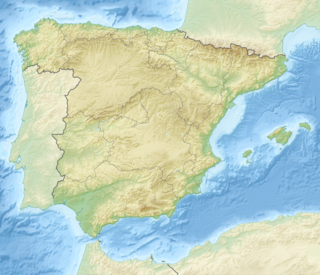
Algeciras is a municipality of Spain belonging to the province of Cádiz, Andalusia. Located in the southern end of the Iberian Peninsula, near the Strait of Gibraltar, it is the largest city on the Bay of Gibraltar. The Port of Algeciras is one of the largest ports in Europe and the world in three categories: container, cargo and transshipment. The urban area straddles the small Río de la Miel, which is the southernmost river of continental Europe. As of 1 January 2020, the municipality had a registered population of 123,078. It forms part of the comarca of Campo de Gibraltar.

La Línea de la Concepción is a Spanish city in the province of Cádiz in Andalusia. It lies on the eastern isthmus of the Bay of Gibraltar, north of the Gibraltar–Spain border, which lies north of the British overseas territory of Gibraltar, with which it has close economic and social links. It is situated on the sandy isthmus which unites the Rock of Gibraltar with the coast in the eastern flank of the Bay of Gibraltar, between Sierra Carbonera and the Rock of Gibraltar.

Estepona is a town and municipality in the comarca of the Costa del Sol, southern Spain. It is located in the province of Málaga, part of the autonomous community of Andalusia. Its district covers an area of 137 square kilometers in a fertile valley crossed by small streams and a mountainous areas dominated by the Sierra Bermeja, which reaches an elevation of 1,449 m at the peak of Los Reales.
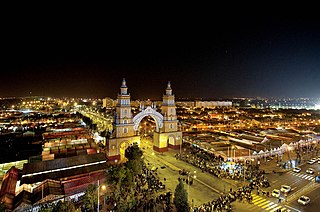
The Seville Fair is held in the Andalusian capital of Seville, Spain. The fair generally begins two weeks after the Semana Santa, or Easter Holy Week.

San Roque is a small town and municipality in the south of Spain. It is part of the province of Cádiz, which in turn is part of the autonomous community of Andalusia. San Roque is situated a short way inland of the north side of the Bay of Gibraltar, just to the north of the Gibraltar peninsula. The municipality has a total surface of 145 km2 with a population of approximately 25,500 people, as of 2005. Its name is Spanish for Saint Roch, a Christian saint who was revered in a shrine dating back to 1508 that predates the foundation of the town.

Medina del Campo is a town and municipality of Spain located in the autonomous community of Castile and León. Part of the Province of Valladolid, it is the centre of a farming area.

Algeciras Club de Fútbol is a Spanish football team based in Algeciras, in the autonomous community of Andalusia. Founded in 1912 it plays in Segunda División B – Group 4, holding home matches at Estadio Nuevo Mirador.
Alonso Hernández del Portillo (1543–1624) was a Spanish local politician and historian, remembered for being the first chronicler of the city of Gibraltar.

Fair of Albacete is a fair celebrated from 7–17 September in the city of Albacete, Spain, to honor the Virgen de los Llanos. It was declared Festivity of international interest, it takes place in the permanent fairground commonly known as 'the pan' or 'the circles' situated near the centre of the city. It has a very well-known bullfighting activities and hundred of other takes place during the days, and the city gets to quadruple its inhabitants during the festivity.

Cala Arenas is a beach situated near the city of Algeciras in Spain, within the El Estrecho Natural Park. It is located at the southern end of the Bay of Gibraltar and faces the Strait of Gibraltar. It measures about 400 metres (1,300 ft) long by about 30 metres (98 ft) deep. The beach is somewhat difficult to access, but can be reached via coastal paths from Punta Carnero and Punta del Fraile. It consists of a series of three small coves of similar appearance, with beaches of rocks and small stones. Both the terrestrial and marine environment of the area lies within the natural park. Its surroundings are largely undisturbed by human activity; the nearest settlement is the coastal community of Getares, a small outlying development of the city of Algeciras located about 1 km to the north. The beach is framed by cliffs and the Isla de las Palomas lies a short distance offshore.

Municipal Museum of Algeciras is a museum in Algeciras, Spain, located at the northern end of the Parque de las Acacias de Algeciras. It was established in 1995 and is run by the city's cultural department. It houses a large collection of archaeological items which were found in different parts of the city. With its two main divisions, archaeology and history, the museum documents three periods in the city's history: Roman-Byzantine Algeciras, the Andalusian city, and the modern era. A third division, religious art, is located in the Capilla del Cristo de la Alameda.

Algeciras Municipal Library is a public library network in Algeciras, Spain. Its headquarters are at the Biblioteca Cristóbal Delgado, located on Salvador Allende Street. There are two branches, including one in the Saladillo neighborhood, Biblioteca El Saladillo, and another in the La Granja neighborhood, Biblioteca Pérez Petinto. In addition to its book collection and reference materials, the institution offers a variety of cultural activities such as a book club. The library is run by the municipality. It was established in 1925 by the local historian Manuel Pérez-Petinto y Costa.
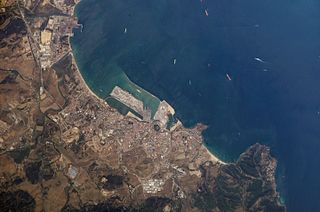
The siege of Algeciras (1342–44) was undertaken during the Reconquest of Spain by the Castillian forces of Alfonso XI assisted by the fleets of the Kingdom of Aragon and the Republic of Genoa. The objective was to capture the Muslim city of Al-Jazeera Al-Khadra, called Algeciras by Christians. The city was the capital and the main port of the European territory of the Marinid Empire.
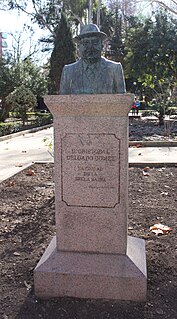
Cristóbal Delgado Gómez was a Spanish historian, musician, and author. He was considered the leading expert on Algeciras, having written many books about the city and being employed as the city's official historian. He worked as an officer of the Central Government from 1943 until 1990.

The siege of Algeciras (1369) was undertaken during the period of the Reconquest of Spain by Muhammed V, Sultan of Granada to reclaim the city of Al-Hadra Al-Yazirat, called Algeciras by the Christians, in the Kingdom of Castile. The siege lasted just three days, and the sultan was victorious. The Muslims thus regained a major city which had been in Castilian hands since Alfonso XI of Castile took it from the Moroccans after the long 1342–1344 siege. Ten years after the capture of the city, in 1379 the sultan of Granada decided to completely destroy the city to prevent it falling into Christian hands. It was impossible to defend the place at a time when the Muslim kings of the Iberian Peninsula had lost much of military power they enjoyed in earlier centuries.

Iulia Traducta was a Roman city in Andalusia, Spain, on the site of the modern Algeciras.
The Feria Real de San Roque, known as the Royal Fair of San Roque in English, is San Roque's main street fair, held on the second Tuesday of each August. It is located in the El Ejido fairground.
Pablo Lozano Martín, commonly known as La Muleta de Castilla, was a Spanish bullfighter and fighting bull cattle rancher, owner of cattle raising Alcurrucén and "Hermanos Lozano".

The Plaza de Toros de Pontevedra (Spain) is the bullring of the Spanish city of Pontevedra and the only one in the autonomous community of Galicia. It has a capacity of 7,800 spectators and is classified as the second category of Spanish bullring. The current bullring replaced a wooden one dating from 1892, although the tradition of bullfighting in Pontevedra dates back to the 17th century.
